Day #11: Saturday, April 23
France: Sunny, approx 27 degrees...
This weather is just incredible!! Another beautiful sunny day in France. The French are concerned as it bodes for a steaming summer. However, we are happy to be thawing out after the cold weather in Turkey.
Our first stop today was the VC Corner Cemetery in Fromelles. It is the only all Australian cemetery in France. And the Australian forces were the ONLY purely volunteer force during World War I. Under the two crosses as you walk into the cemetery are buried 410 men. Who they are is unknown. The names of 1294 soldiers who have no known grave are listed on the memorial wall at the back of the cemetery. Today, Rachel and I came here to make a tribute to our diggers who have no known grave.
 |
| The flat ground surrounding the cemetery.... |
 |
| In the two sections on the left and right (where you can see garden beds) is where 410 men are buried... |
My research focused on one of three brothers: the great-uncle of one of my friends and colleagues: Ceridwen Message. Today I stood in front of the group and spoke to them of Private Thomas Henry Phillip Shephard, a brush maker. He was 22 years old when he went missing in action at Fromelles. His body was possibly identified by the mole on the small of his back or by the scar on his right wrist. Perhaps he was identified by his “fresh complexion, brown eyes and brown hair” as was listed on his enlistment papers. His mother, Ellen, was notified of his death six months after he went missing in action on the 19th of July, 1916 – the start of the Battle of Fromelles.
 |
| Thomas Henry Phillip Shephard |
Thomas Henry Phillip fought in the 60th Infantry Battalion. The 60th consisted of veterans from Gallipoli and also new recruits. Thomas was one of those new recruits having joined the Australian Imperial Forces on July 19th, 1915 in Melbourne. The 60th arrived in France on 28th June and their first test in battle was at Fromelles on the 19th of July. Exactly one year after enlisting, Private Thomas Henry Philip Shephard was reported missing in action. This was later updated to killed in action. Thomas received the Victory medal; his niece is in possession of it today.
Not only did Ellen receive notification of Thomas’ death, but also of her two other sons: George Arnold, also killed at Fromelles on or around the same date, and John Ernest who died from rheumatic fever in a hospital in Marseilles. John is buried in Mazargues War Cemetery; George is also commemorated here in VC corner.
 |
| George Arnold Shephard |
 |
| John Ernest Shephard |
The family did not receive notification via telegrams, the duty of telling the family fell to the local Church Of Christ priest. Apparently, after making the first notification, the priest refused to go back to the Shephard household to inform Ellen that her two other sons had also sacrificed their lives in the war. Ellen’s granddaughter is in possession of a postcard that reads: “Mrs Ellen Shephard, Mother of 3 sons given to the Empire. 1 dead, 1 said to be dead and 1 missing.” Thomas and his younger brother George lie somewhere here on the battlefield of Fromelles. The Great War, the War to End All Wars was a devastating experience for the Shephard family.
 |
| The main part of the pin reads: "Issued by Dept of Defence to Women of Australia"....the pin itself represents the loss of one son, the two bars represent the loss of two more sons.... |
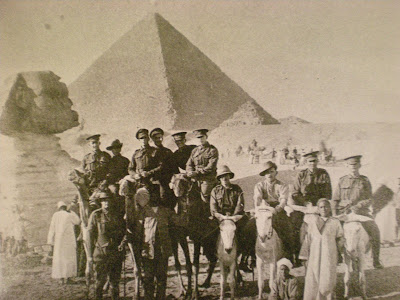 |
| A postcard the boys sent from Egypt to their Mum....the boys are believed to the third, fourth and fifth men from the left...one of the brothers is in shadow.... |
In July 1921, Ellen received a letter from for the Officer in Charge of Base Records. It stated: “I regret very much that, notwithstanding the efforts of Grave Services Unit, we have so far been unable to obtain any trace of the last resting place of your son the late No. 2778 Private T.H.P Shephard, 60th Battalion and so that no possible source of information shall be overlooked., I shall be much obliged if you will let me have on loan any letters or communication that contained any reference to the circumstances surrounding his death, particularly the exact locality where at which it occurred or where he was last seen alive.” Thomas’ exact resting place is unknown.
The first major battle that Australians faced on the Western Front was here at Fromelles. The purpose of the attack was to draw the Germans away from the main offensive. Sadly, the Battle of Fromelles was a complete failure as the Germans became quickly aware that it was only a diversion. Of the 60th Battalion, there were seven hundred and fifty seven casualties on the first day. Five thousand, five hundred and thirty three Australian soldiers died on the battlefield where we stand today. One of those was Private Thomas Henry Phillip Shepherd. Today we stand here to honour his sacrifice and the sacrifices of all of Australian Diggers here on the Western Front.
Lest We Forget.
 |
| George and Thomas' names on the Wall of Remembrance.... |
Again, it was incredibly difficult to stand in front of the group and speak about Thomas. Having met Thomas’ niece, Ceridwen’s mother, Glenda, it was a much more personal experience to talk about what happened to Thomas and his two brothers. As much as I could, I tried to take in as much of the views from the cemetery and the details of the cemetery itself so that I could pass that information on to Glenda when I return home. The battle held here was a complete disaster!
 |
| Ethel Shephard; John, Thomas and George's younger sister....the beads she is wearing were sent from by the boys from Egypt.... |
There were no achievable objectives or support during the Battle of Fromelles. What was originally intended as a feint failed miserably. The Australians did not have enough gun placements. The Germans waited for the first men to enter the killing fields and used grazing machine gun fire to cut them down. There were only two lines of trenches, instead of the usual three as the water table made it so hard to dig trenches. The attack was a debacle and was reported in the British press as a ‘raid’. It is estimated that 5,500 Australians were killed or wounded. There were no gains made at all here. It was a complete failure. The poor bastards really didn’t have a chance.
VC Corner is located on what was no-man’s-land during the war. ‘VC Corner’ was the name given to a nearby road junction….perhaps for the gallantry of the men who fought here. For a small little cemetery, it really packs a punch. It was nice to see some daffodils blooming in the ground alongside the 410 unknown soldiers. A little bit of colour and cheer to keep the boys company. On behalf of the Ringwood R&SL, I laid a wreath in honour of the men who died here.
Just up the road from VC Corner Cemetery is the Australian Memorial Park which has the iconic ‘Cobbers’ statue. The statue commemorates those Australians who fought and died during the Battle of Fromelles on 19-20 July, 1916 and is of Sergeant Simon Fraser with a wounded man of the 60th Battalion. After the battle at Fromelles, many men ran out into no-man’s land to rescue a wounded mate. Risking their lives for their mates. That spirit of ANZAC is embodied in Peter Corlett’s bronze sculpture. The twin lives in Melbourne on the grounds of the Shrine of Remembrance. It’s a fantastic sculpture that clearly shows endeavour, mateship, comradeship and all of those things that embody the spirit of ANZAC! It’s because of people like this that we are here today. We all had a great time taking photos….there goes the schedule, Bob!!
Pheasant Wood is a short drive away from VC Corner and the Cobbers sculpture. The cemetery here was a purpose built cemetery and built up so that it would be on a rise. It was near here that a mass grave was discovered by Lambis Englezo and he went about trying to identify the bodies that were in the grave. Apparently there is a small blue flower that grows only in that area in the summer. Perhaps marking the spot for all those years. The cemetery here contains about 250 British and Australians who died at Fromelles.
 |
| "Now I'm at peace free to roam wherever my family speaks my name" Forever loved by his family |
 |
| The Kurrajong Boys.... |
 |
| We have not forgot you Cobber |
It was here that Helen and Ash made their tributes to their adopted diggers. As you can imagine, this cemetery sees a lot of traffic since the discovery of the mass grave and reburial of the men in 2010. Hadley and Tom once again played for us and for the other pilgrims arriving at the site. Hadley once again knocked out a brilliant Last Post and Tom played a very poignant ‘Amazing Grace’. So fitting for the venue and so relevant for the many men who were previously lost and now, being found, can rest with their mates. The boys certainly silenced and moved their growing audience. I know I was moved (once again!) by their musical tributes.
 |
| Now with military honours he, lost in the "Great War" has a final resting place "Present and accounted for" |
 |
| A wheat grain dies here A grateful family harvest flourishes there and even more fondly remembered |
The Canadian equivalent of Menin Gate is the memorial at Vimy Ridge. It was here at Vimy Ridge (or Hill 145) that the Canadians divisions fought under Canadian command. Over 3 days, 3598 were dead and 6664 were wounded. The memorial was one of the last to be built on the Western Front and one of the most moving. The marble used to make the memorial was taken from a disused quarry on the Adriatic Coast and took 11 years to build. Walking up to the memorial, from behind, it is an imposing structure. It is only when you reach the front of the memorial that the sadness and devastation that occurred here becomes evident. There is a woman (representing Canada and mothers) with grief written all over her face. Other elements include a man breaking a sword (a symbol of sacrifice??) and on the way to the memorial there is a line of maple trees; reminiscent of our avenues of honour. The memorial has commanding view over the countryside and is quite a sombre place to visit. Beautiful, but sombre.
 |
| In the trenches.... |
 |
| Craters left from the war.... |
 |
| The memorial in the background.... |
 |
| Huge, even from a distance!! |
 |
| The memorial was opened in 1936.... |
 |
| Some of the names.... |
Everyone loves a treasure hunt and Bruce promised a grand prize (which I think ended up being Belgium chocolate….grand indeed) for the first person that could find an ‘unusual’ grave in Bailleulmont Communal Cemetery in Arras. Rachel found the grave of Private A Ingham who was shot at dawn during the war. The reason most people come to this cemetery is that his is the only headstone of over 303 British soldiers who were executed that states the cause of his death:
Shot at dawn
One of the first to enlist
A worth son
Of his father
Ingham was executed for desertion. The Canadians, the French and the British all execute their own during the war. The saddest being Guardsman Benjamin O'Connell of the Irish Guards who was shot on the day the British Army started its march to victory. The Germans also execute around 86 of their own soldiers. Those that were executed have now been pardoned.
The cemetery is an extension of the communal cemetery and it was interesting to note the way in which the French bury their dead. Similar to us there are headstones, but bolted down on the headstone are personal memorials from different family members.
At Bullecourt, we stopped to look at the slouch hat memorial that was built “In memory of the Australian and British soldiers who fell in this area - April/May 1917”. My enduring memory of this stop will be European bumblebees. Fat, buzzing bees that looked like fat bullets buzzing over the ground where blossom had fallen to ground.
The Bullecourt Digger, another Peter Corlett sculpture, shows an Australian soldier, wearing the uniform of the AIF (Australian Imperial Forces) at the Battles of Bullecourt. As the information plate on the sculpture states: “the Bullecourt Digger is sturdy, Arcadian, audacious and resolute. Importantly as well, the sculpture expresses the hope that the deeds of Australians at Bullecourt in April/ May 1917 would be of enduring relevance and inspiration to this and future generations”.
 |
| The Bullecourt Digger.... |
 |
| We're certainly not forgotten in this part of the world!! |
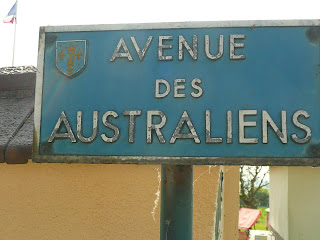 |
| Ditto! |
Mont St. Quentin (and I STILL can’t get the pronunciation right….my French sucks!!) was critical as it overlooked the town of Perrone. The memorial that was placed here was the only one torn down by the Germans in World War II.
We stopped in Perrone for a pit stop and drinks while we waited for the Channel 9 news camera crew to find us. A great little town and the café where we ordered drinks (hot choccy for mine)had signs up proudly declaring “We do not forget Australia”. Kinda melts your heart a bit!
After rendezvousing with the camera crew and the reporter, Mark Burrows, we went to Perrone Communal Cemetery Extension for Laura’s commemoration. She was understandably very nervous about doing her tribute in front of the camera, but also as she was talking about her great-grandfather. She spoke extremely eloquently about her ancestor and it appeared that even a hardened journo like Mark Burrows was moved. At the end of the ceremony, it was great to see the kids all move in for a group hug….nice working of the camera!! Hopefully everyone at home will get to see the footage???
After rendezvousing with the camera crew and the reporter, Mark Burrows, we went to Perrone Communal Cemetery Extension for Laura’s commemoration. She was understandably very nervous about doing her tribute in front of the camera, but also as she was talking about her great-grandfather. She spoke extremely eloquently about her ancestor and it appeared that even a hardened journo like Mark Burrows was moved. At the end of the ceremony, it was great to see the kids all move in for a group hug….nice working of the camera!! Hopefully everyone at home will get to see the footage???
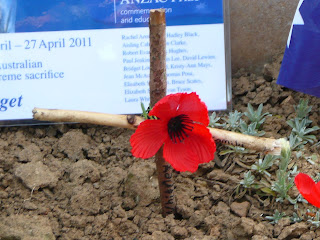 |
| Laura's hand-made cross.... |
 |
| Awwwwwwwwwwwwww.... |
 |
| A German grave in the Perrone Communal Cemetery Extension.... |
Lastly today, we stopped at Prospect Hill Cemetery in Guoy (pronounced gooey J ) for Nick’s tribute to a Xaverian who died during the war. It was the most picturesque setting: green fields, golden fields of canola, a warm spring day and birds happily chirping in the breeze. What a fitting and lovely place to rest after a touch and unforgiving war.
 |
| Nick's tribute.... |
 |
| Such a beautiful setting....the yellow is canola growing in the background.... |
Easter Sunday tomorrow….hopefully Mum has remembered to keep me some Cadbury Crème Eggs!! More of the Western Front and a trip to VB tomorrow….








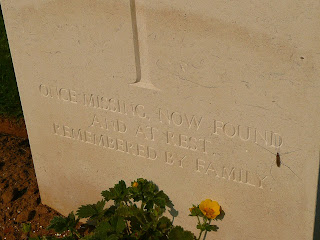
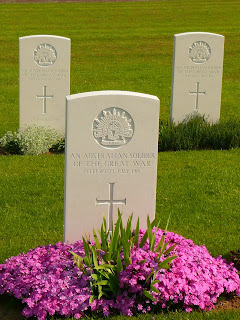












No comments:
Post a Comment